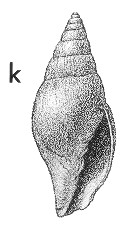
Revised descriptions of New Zealand Cenozoic Mollusca from Beu and Maxwell (1990)

 | Revised descriptions of New Zealand Cenozoic Mollusca from Beu and Maxwell (1990) | 
|
  (Pl. 27k): GS 12161, CH/f23A, Whenuataru Tuff, cliff-top outcrop north of "The Point" homestead, west of Flowerpot Harbour, Pitt Island, Chatham Islands, Waipipian (GNS) |
Beu & Maxwell (1990): Chapter 12; p. 248; pl. 27 k.
Synonymy: Proximitra banksi Dell 1951, p. 54
Classification: Volutomitridae
Description: Largest New Zealand member of family (30-55 mm high), most specimens almost smooth apart from faint growth lines, with weakly inflated whorls, thin apertural lips, moderately long, almost straight, widely open anterior canal, and 3 prominent, narrow columellar plaits. Outer lip with long, very shallow sinus occupying upper half of lip, swinging forward weakly opposite neck, then contracted sharply ("cut away") to canal tip (slightly incomplete on figured specimen). Well preserved specimens with sculpture of low axial costae and 7 spiral grooves on first 3 spire whorls, fading out down spire, and about 10 low spiral cords around neck, but these are not seen on most fossils. Protoconch not well preserved, dome-shaped, of about 2 apparently smooth whorls.
Comparison: The superficial lack of sculpture, the elongate fusiform shape, and the large size among New Zealand late Neogene mitriform gastropods make Volutomitra banksi easily recognised. Cernohorsky (1970a, p. 100) showed that V. banksi is a typical species of Volutomitra closely resembling the type species, V. groenlandica (Beck in Moller, 1842) and the northern Pacific V. alaskana Dall, 1902. Cernohorsky (1981c, p. 1000) further considered the New Zealand taxon Waimatea Finlay, 1926 to be a subgenus of Volutomitra, presumably differentiating the two by the prominent sculpture present on many V. (Waimatea) species. However, the type species of Waimatea, Mitra inconspicua Hutton (Pl. 8i), is almost smooth and closely resembles species of Volutomitra (sensu stricto). Maxwell (1992, p. 135) considered that these taxa intergrade, and "somewhat reluctantly" synonymised Waimatea with Volutomitra.
Distribution: Waiauan-Recent; Recent, New Zealand (type); not uncommon in the bathyal zone around New Zealand, especially off south-eastern South Island. Fossil specimens have been examined from Glenafric, North Canterbury (Waiauan), southern Wairarapa (Tongaporutuan; Beu 1970c), Palliser Bay (Mangapanian-Nukumaruan; Beu 1967a), Oaro, Marlborough (Nukumaruan; Beu 1979) and nearby Nukumaruan localities in North Canterbury, the illustrated Pitt Island specimen (Waipipian), and GS8310, rail cutting, Kapara, Blenheim, Marlborough (Mangapanian?), so the species is apparently uncommon but widespread in late Middle Miocene to Recent bathyal facies.
Cite this publication as: "A.G. Beu and J.I. Raine (2009). Revised
descriptions of New Zealand Cenozoic Mollusca from Beu and Maxwell (1990). GNS
Science miscellaneous series no. 27."
© GNS Science, 2009
ISBN
978-0-478-19705-1
ISSN 1177-2441
(Included with a PDF facsimile file
copy of New Zealand Geological Survey Paleontological Bulletin 58 in CD version
from: Publications Officer, GNS Science, P.O. Box 30368 Lower Hutt, New
Zealand)